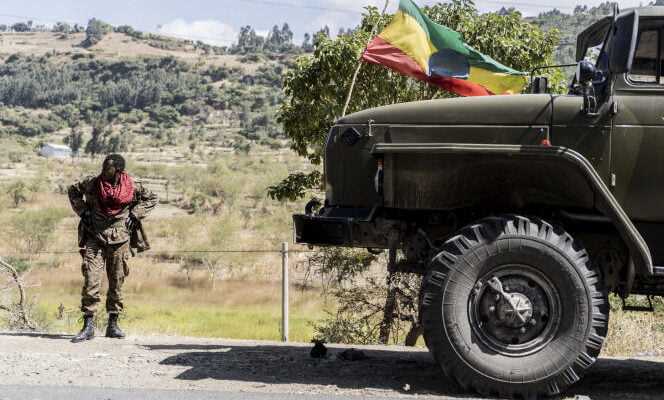To not miss anything on African news, subscribe to the newsletter of World Africa from this link. Every Saturday at 6 a.m., find a week of current events and debates treated by the editorial staff of World Africa.
The fighting in the province of Tigray is not over, contrary to what the Ethiopian government would have us believe. Prime Minister Abiy Ahmed said on Friday January 7 that he would ” end this war peacefully based on the principles of Ethiopian humility “.
A few hours later, 600 kilometers north of the capital Addis Ababa, drones from its federal army bombarded a camp for displaced people in Dedebit, in central Tigray, killing at least fifty-nine civilians. And another strike on Monday, January 10, claimed the lives of seventeen people in the south of the province, near the town of Mai Tsebri, according to humanitarian and hospital sources.
This gap between speech and action is a reflection of the new phase into which the Ethiopian civil war has entered: ambivalent. From mid-December, the rebels of the Tigrayan Defense Forces (TDF) gradually withdrew to their region after suffering several setbacks.
Since then, the two armies have faced each other at the borders of Tigray. Pro-government forces have established a cordon around the province, with Abiy Ahmed unwilling to pursue the insurgents within their territory. Perhaps to avoid a new guerrilla war in the mountains of the region, or, as he wrote in a statement on December 24, to avoid ” that local communities [tigréennes] attack the army [éthiopienne] in his back “.
Possible talks
However, some international partners consider the current situation rather conducive to possible talks. Indeed, for the first time since the start of the conflict, the two parties are virtually confined to their respective territories, one of the preconditions for any negotiation.
Another reason for hope: the publicly displayed will by the two camps to put an end to the war. In a letter addressed to the Secretary General of the United Nations on December 19, Debretsion Gebremichael, the leader of the Tigray People’s Liberation Front (TPLF) – the political matrix of the TDF – called for the establishment of a ceasefire. fire.
Abiy Ahmed, after having stopped his troops at the gates of Tigray, decided to release about thirty political opponents to start a national dialogue of reconciliation. Among them, six members of the TPLF, yet placed on the list of terrorist organizations by Parliament.
If his priority remains ” protect [sa] military victory by any means possible “, he said in a press release published on January 8 that ” second, we will confirm the victory with political and peaceful initiatives “.
“Relatively constructive phase”
Are these, finally, the premises of a real negotiation or of an umpteenth truce before a new resumption of hostilities? Caution is advised, according to an American diplomat: ” Lhe trajectory of the conflict has been unstable since its inception. (…) In recent days, the Prime Minister has started to send more positive signals. The Tigrayan side has also publicly committed to dialogue. On the other hand, given what we have seen in the past, it is difficult to know how long this relatively constructive phase will last. “
A legitimate doubt in view of the latest events. Speeches of good intentions are not followed by effects on the military ground. The week was the scene of low intensity clashes on the various fronts in Tigray.
” A few ground attacks by Tigrayan forces have resulted in skirmishes, to which the government responds with airstrikes, decrypts the independent researcher Mengistu Assefa, attached to the New Generation University of Addis Ababa. All of this could sabotage the window of opportunity for a ceasefire. “
Airstrikes have become commonplace on the part of Addis Ababa, which recently acquired an arsenal of drones. Abiy Ahmed’s government is using a fleet of Turkish, Iranian and Chinese aircraft acquired over the summer to counter the TDF offensive, which approached in November within 200 kilometers of the Ethiopian capital.
Renewed violence
According to a humanitarian count, these bombings have killed at least 202 civilians in Tigray since mid-October. The last, Tuesday, January 12, killed two people in the vicinity of Mekele, where the African Union envoy for the Horn of Africa, Olusegun Obasanjo, was earlier today. The former Nigerian president was talking to the Tigrayan leadership there. A Western diplomatic source assures us that the envoy went there with concrete proposals from the Ethiopian authorities.
The situation on the ground is also blurred by Asmara’s involvement. Neighboring Eritrea, engaged since November 2020 alongside the Ethiopian army against the Tigrayan rebels, is accused by the TDF of carrying out attacks in the north of the province. The United Nations humanitarian agency (OCHA) confirms a resurgence of violence.
In a national television interview on January 8, Eritrean President Isaias Afwerki claimed that ” this disruptive element [TPLF] was to be neutralized for the future existence of Eritrea “. Fatalist, the American diplomat already quoted regret ” the non-constructive role “ of Asmara in the crisis.
In addition, this new phase of the war is disrupting humanitarian supplies, while at least 400,000 people live in conditions close to famine in Tigray, according to the United Nations. Aid agencies have suspended activities in the northwest of the region after airstrikes by the Ethiopian government.
UN agencies say they run out of medicine and gasoline to assist Tigrayans, who are once again cut off from the world. The province is under total blockade. No humanitarian convoy has been allowed to enter the region since December 15.
